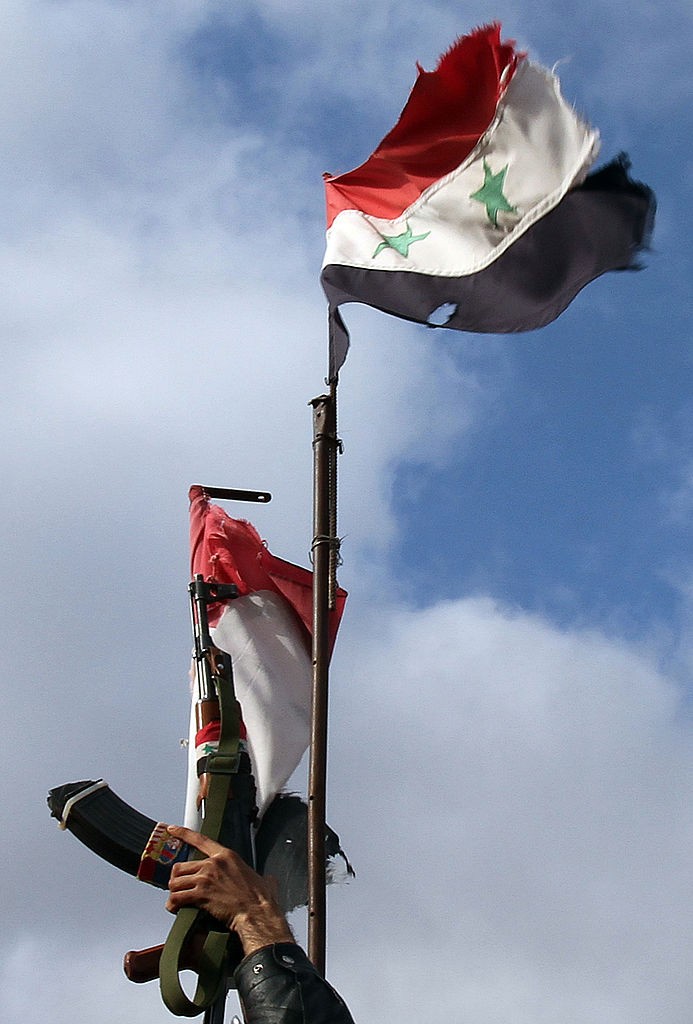
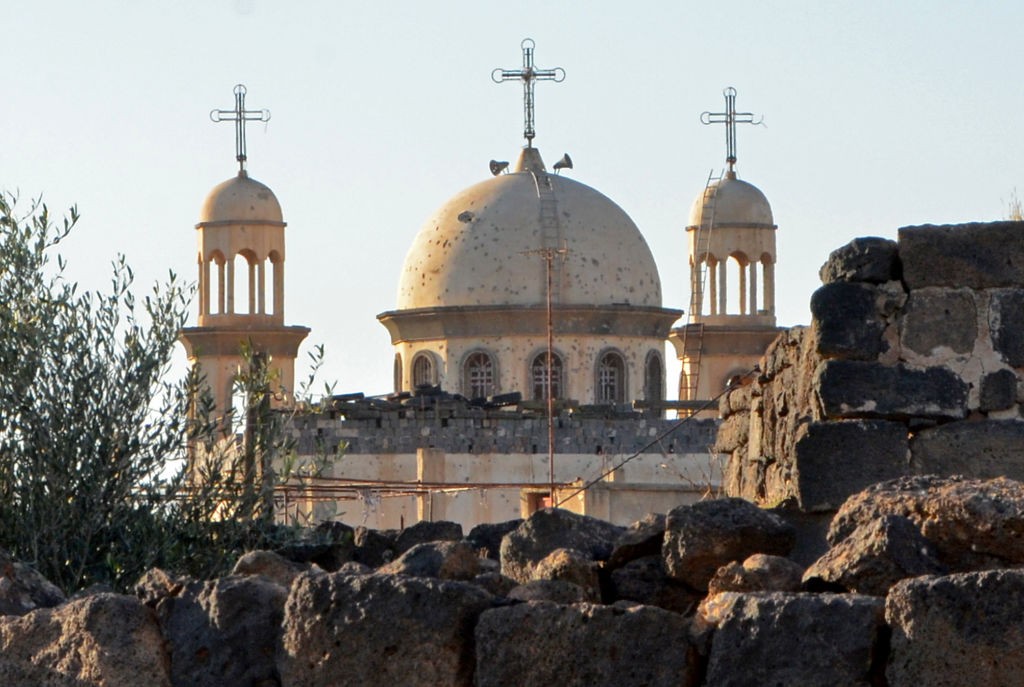
Summary
Minority communities in south-west Syria have shrunk to a fraction of their pre-2011 size, and the regime’s repressive policies in the south-west perpetuate a cycle of violence and chaos that prevents their safe return. The regime’s strategy of transforming minority communities into sources of militia fighters has not only led to the deaths of thousands of young Alawite and Shi’a men, but also created sectarian tensions between formerly interconnected communities in south-west Syria. Heightened sectarianism stoked by the regime, alongside intense shelling and bombardment, has also contributed to the flight of Christians from their traditional communities, while Suwayda’s Druze increasingly find themselves victims of regime- and Hezbollah-backed efforts to dismantle their relative autonomy. Meanwhile, concerted Russian-led efforts to see Christians and other communities return to the south-west have ended in near total failure, with minorities rejecting a return to this volatile and unstable region. So long as the regime's policy in the south-west is characterized by violence, the safe and dignified return of displaced Syrians will not be possible. This paper studies current and former minority communities in south-west Syria, the security and economic challenges these groups face, and the manner by which the regime exploits and weaponizes these vulnerable Syrians.
Key points
- SHRINKING COMMUNITIES: Tens of thousands Syrian minorities in the south-west have fled to Damascus or left the country, causing these communities to rapidly decrease in size. Compared to pre-2011 numbers, today there are 31 percent fewer Christians, 69 percent fewer Shi’a, and 73 percent fewer Circassians in this area.
- WEAPONIZED COMMUNITIES: The Syrian regime has used minority communities as a centerpiece of its propaganda, promoting itself as a champion of minorities and Syria’s firewall against Islamic radicalism. The regime has intentionally stoked sectarian fears while simultaneously recruiting members of the Alawite and Shi’a communities to join the ranks of allied militias. This weaponization of specific sects has eroded historically strong ties between Sunni, Shi’a, Christian, and Alawite communities in the south-west.
- FAILED RETURNS: Despite efforts by Russia, only 600 Christians have returned to their homes in the south-west following the July 2018 settlement deal — a fraction of the number displaced — and comparably small numbers of other minorities have returned as well. Proposals to return displaced Shi’a and Alawite communities to former opposition territory in Daraa have also been rejected by local authorities, citing concerns about Hezbollah and Iranian militias infiltration. Although the return of Syrian Christians to their homes and the rebuilding of their churches is a centerpiece of Moscow’s propaganda campaign, Russia has seen little success in the south-west.
- ECONOMIC WOES: The Syrian lira is in freefall, a particularly disastrous prospect for minority communities relying on remittances from abroad as their primary source of income. For those who earn an income locally, a lack of basic goods and services and a region-wide recession following empty regime promises to rebuild infrastructure prevent them from living normal lives.
- CO-OPTING MINORITIES: The regime has cultivated relationships with influential members of the Christian clergy, Druze leadership, and Circassian elite, granting these local powerbrokers disproportionate authority and influence in their communities. The result is the erosion of traditional social hierarchies and the appointment of pro-regime minority figures to positions of power.
Methodology: Information gathered by Syrian military, political, and civil experts who have extensive networks of sources across south Syria, including within local governance and the regime’s civil registry offices.

Introduction
Syria’s south-west was once home to tens of thousands of Syrians from minority ethnic and religious groups, from Turkmen and Christians to Shi’as and Circassians. Deep economic and social ties joined minority groups with the Sunni majority, and most of them were largely integrated with their neighbors while retaining their cultural identities. Sunni-Shi’a and Sunni-Alawite marriage, for example, was relatively commonplace, creating ties that endure in some communities until today.
But nine years of violent and repressive regime policy in the south-west has manufactured divisions and driven deep wedges between local communities. A regime insistence on weaponizing Alawites and Shi’as, recruiting them into pro-regime and Hezbollah-supported militias, has both left thousands of young men dead and created deep divides between once-connected communities that are now distrustful of one another. Years of polarizing propaganda by the regime have encouraged minorities to think of self-preservation, presenting a narrative where the regime is fighting a radical Islamist threat bent on eradicating Christians, Druze, Alawites, and others — and the only recourse for those seeking protection is loyalty to Bashar al-Assad. The regime has also cultivated ties with prominent and influential authorities in these various sects, driving many members of these communities to forge closer relations with the regime. The result is not only a distorted portrayal of the regime as a champion of oppressed minorities — one with added resonance in Europe and elsewhere — but also the manufacturing of real, deeply felt, and dangerous divides between once-connected Syrian communities.
The regime has not championed minorities, but rather has placed them directly in danger by weaponizing their members both on the battlefield and in propaganda. For other communities — like the Druze of Suwayda — the threats are more direct: the regime has threatened to deploy its army to impose its authority in the province, while secretly co-opting and infiltrating Druze leadership in the region. Hezbollah and the regime are recruiting Bedouin militias that engage in organized crime, drug smuggling, assassinations, and kidnappings — driving the province to the brink of chaos.
|
Minority Populations* in South-West Syria |
|||
|
Sect |
Population (2011) |
Population (2019) |
Percent change |
|
Druze |
495,000** |
381,000 |
-23% |
|
Christians |
34,378 |
23,762 |
-31% |
|
Shi’as |
12,396 |
3,806 |
-69% |
|
Alawites |
3,269 |
2,535 |
-22% |
|
Circassians |
3,310 |
900 |
-73% |
* Statistics calculated from networks of local sources, including from within the regime’s civil registry.
**Statistic represents Druze population in 2014.
Although the July 2018 settlement deal officially ended armed operations between former opposition and regime forces, the regime perpetuates a cycle of violence that makes the south-west a highly volatile and unstable region unsuitable for safe returns. Widespread arrest campaigns, assassinations, attacks, and crime contribute to mounting public frustration and instability, while sectarian tensions inflamed by violence since 2011 complicate the prospect of returning to the pre-war status quo. Furthermore, the ongoing economic crisis in Syria makes rebuilding or reclaiming once-abandoned homes in the south-west challenging. As long as regime military policy creates an environment that generates instability in the south-west, minority communities will be unable to return in safety and with dignity. As such, only a fraction of displaced minorities has returned, despite concerted efforts by regime intelligence and Russia to restore the populations of certain sects.
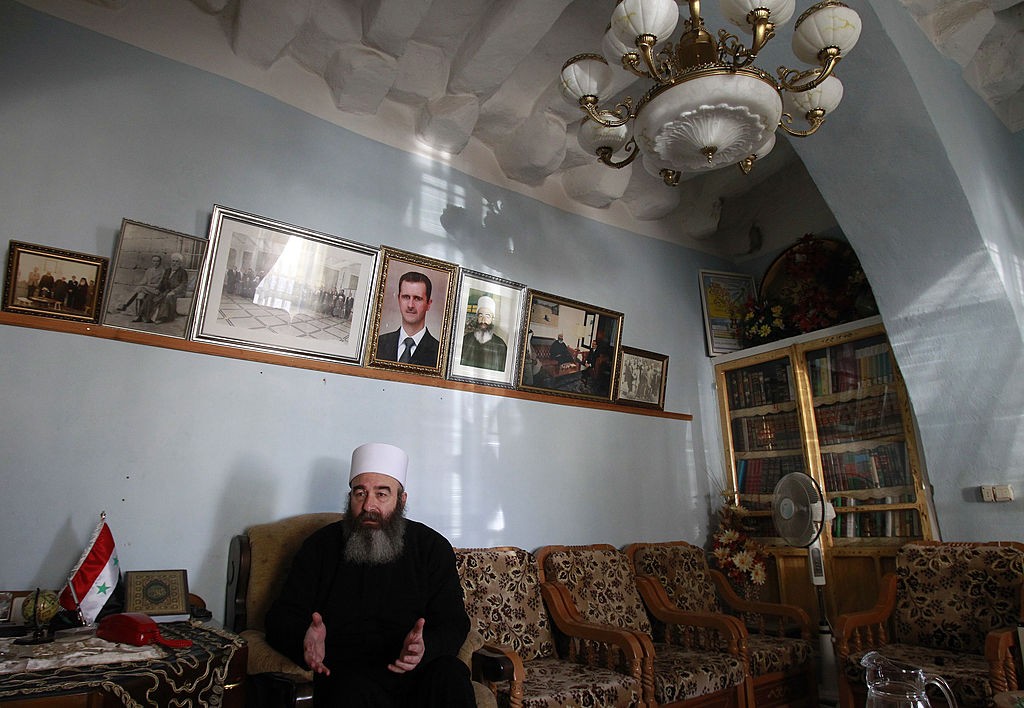
"The Druze of Suwayda Province have a unique relationship with the Syrian regime characterized by relative limited autonomy. ... Yet in recent months Suwayda’s Druze have come under direct threat from Hezbollah and regime intelligence."
Druze
Suwayda’s Druze Under Threat
Nestled between Daraa Province and Syria’s eastern desert, the Druze of Suwayda Province have a unique relationship with the Syrian regime characterized by relative limited autonomy, and the regime has long balked at direct clashes with Suwayda’s powerful local authorities. Yet in recent months Suwayda’s Druze have come under direct threat from Hezbollah and regime intelligence, both of which are recruiting local armed groups to carry out assassinations and attacks on Druze officials and leaders. Hezbollah controls most of these armed groups, composed of local Bedouins, who traffic drugs and weapons in addition to carrying out security operations. This state-sponsored violence and organized crime — coupled with threats by regime Military Intelligence (MI) to attack the province militarily if the Druze do not totally submit to regime rule — threatens Suwayda’s stability, as well as its relative self-administration.
Druze are the largest minority group in south Syria, and the majority of the country’s Druze live in Suwayda Province — although there are a handful of Druze communities in rural Damascus and Quneitra Provinces. Unlike other minority groups in the south-west, the Druze have largely avoided being uprooted from their communities, turning inwards for both protection and economic stability. Still, this threatened community is in decline — where the Druze in Suwayda numbered 495,000 in 2014, 381,000 remain today, more than a 23 percent decrease due largely to emigration or relocation to elsewhere in Syria.
Economic Decay & Untenable Future
Displacement and emigration have taken a particularly heavy toll on men: 40,000 young men have fled Suwayda since 2012 to avoid military service. Many others left to work on a temporary basis in the Gulf states and simply choose not to return. Thousands more Suwayda residents left their homes to find work elsewhere in the country. Unemployment and other economic woes compound a consistent lack of services such as electricity and waste collection, as well as political repression and fear of violations by the regime in the province. In early December 2019, the regime added 20,000 additional names to their registry of wanted individuals — most of them young and middle-aged men — to be detained at checkpoints. This raised the total number of Suwayda’s wanted to approximately 73,000 individuals, a large swath of the local workforce.
The country’s crisis-ridden economy is another major motivation for the Druze exodus from the province. Most of Suwayda’s remaining Druze rely on remittances from diaspora populations abroad, with less than half supporting themselves via government jobs or local businesses. There are exceptions to this reliance on remittances among Druze populations close to the Golan Heights, specifically in the town of Hader and surrounding region. Quneitra’s Druze draw most of their income from agriculture and government jobs, appearing to be more stable and self-sufficient than their counterparts in Suwayda.
With economic and existential threats mounting, Suwayda’s population continues to shrink as life becomes less tenable. ETANA Syria surveyed dozens of Druze residents of Suwayda Province in December 2019. Of the 52 respondents — hailing from both rural and urban communities — all said that they would leave Syria if given the chance. All but one respondent called life in Suwayda Province unsuitable, citing both economic and security concerns in light of the proliferation of weapons, kidnappings, and criminal gangs.
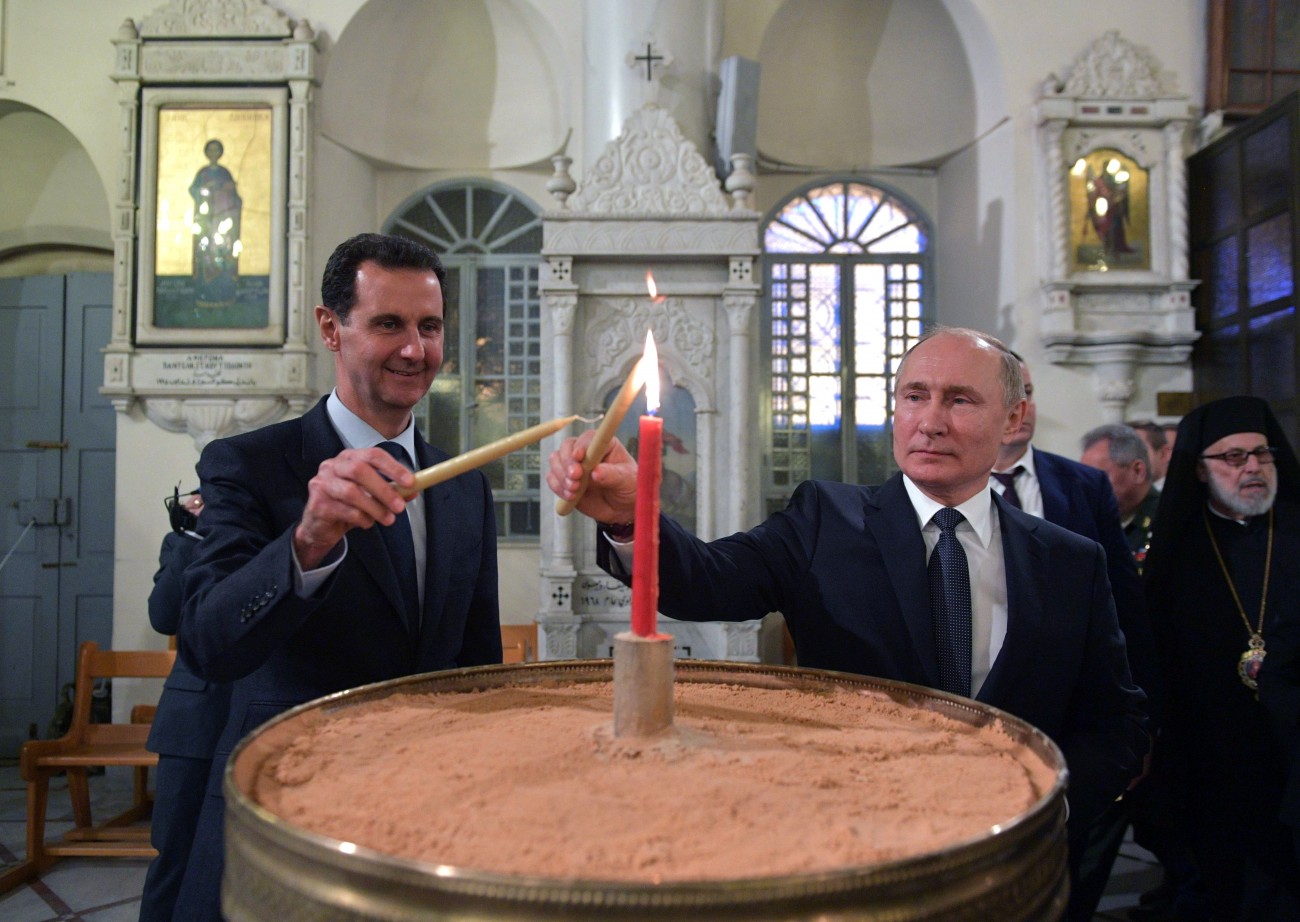
"Russia has frequently cited the defense of Christian communities as a prime motivator for its intervention in the conflict. ...Yet Russian assistance with Christian returns has resulted in almost total failure."
Christians
Shrinking Communities
The Christians of the south-west are relatively diverse: approximately 60 percent belong to the Orthodox Church, while 40 percent are followers of the Catholic Church. Other denominations, primarily Protestants, exist in very small numbers. Unlike some other sects in the south-west, church officials and religious authorities play an important role in local politics. Ecumenical councils, especially in the early years of the war, helped to provide humanitarian aid to Christian internally displaced persons (IDPs) in Suwayda and elsewhere. This ecclesiastical hierarchy is also strongly linked to the regime; Christian leadership in Damascus and elsewhere has, on numerous occasions, publicly displayed loyalty and gratitude to Assad. In this way, church leaders have come to play a key part in the regime’s propaganda machine regarding the defense of minorities.
Nearly every Christian community in south-west Syria has shrunk following the violence initiated by the regime in 2011 with the killing of unarmed protesters in Daraa city. Subsequent regime shelling and bombardment of the city, as well as ground fighting elsewhere in the south-west, pushed many of Daraa’s Christians to initially flee toward Suwayda before relocating to Damascus, where most remain today. Russian attempts to promote the return of Christians have failed, due in no small part to the instability and volatility in the south-west, where a destructive cycle of violence is perpetuated by aggressive regime policies in violation of the 2018 settlement agreement.
Russia has frequently cited the defense of Christian communities as a prime motivator for its intervention in the conflict. At a meeting and press event with leaders from the Russian Orthodox Church in December 2017, Russian President Vladimir Putin vowed to rebuild Christian communities in Syria. Putin stressed that historic Christian communities had been “liberated,” and that the return of Christians and reconstruction of churches would be a priority for Moscow. Such statements, mirrored by Syrian regime propaganda, resonate with certain elements of Christian society even in the West, and form one of many purported justifications for Russia and the regime’s continued use of violence in Syria.
Yet Russian assistance with Christian returns has resulted in almost total failure. Whereas 34,378 Christians once lived in Daraa and Suwayda provinces in 2011, they now number 23,762, a reduction of approximately 31 percent. Although semi-official records indicate that as many as 60,000 Christians live in Daraa Province, these numbers are likely highly inflated by both the regime and religious authorities attempting to downplay or hide the effect of emigration and displacement on these communities. A large portion of those who fled the south-west now reside in Damascus, while others have fled the country entirely. Now firmly established in the capital or abroad, the displaced face significant hurdles impeding their return home. Thus far, only 600 Christians have returned to their areas across the entirety of Daraa and Suwayda.
Barriers to return
Further complicating the return of Christian communities is the re-purposing of Christian-owned properties. In many former Christian-predominant areas, displaced Syrians or local residents have taken possession of Christian homes left abandoned for more than half a decade, and securing these homes requires either evicting those who now reside inside them or negotiating with landlords who have taken control of these properties. Perhaps the most prominent example of this dynamic is in the two former Christian villages of Kharaba and Jbeb in Suwayda Province, where Bedouin IDPs claimed the empty homes of Christians who had relocated to Damascus. Months-long negotiations involving local figures, Russian officials, Syrian Christian Parliamentarian Riyadh a-Shetawi, the 5th Corps, and others have produced numerous plans to relocate the IDPs and bring Christians home — none of which have come to fruition.
The logistical challenges of peacefully relocating IDPs living in Christian homes, along with ensuring the safety of returning Christians themselves, joins a slew of political issues that have delayed returns for more than a year. Even if such barriers could be overcome, few Christians are likely to risk returning to a volatile, unstable south-west.
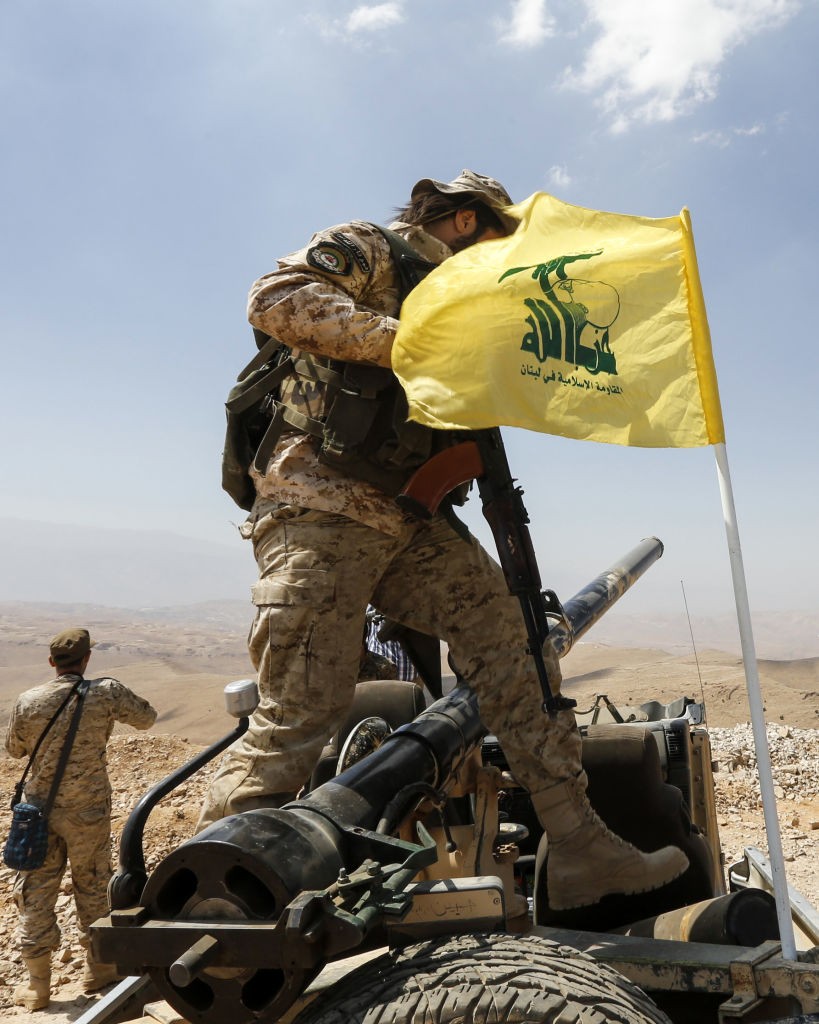
"The weaponization of Daraa’s Shi’a community has pushed many local Syrians to associate the sect’s members with Hezbollah or the regime, further dividing the once largely homogenous south-west along sectarian lines."
Shi’as
Prior to 2011, the Shi’a community of south-west Syria was largely integrated with neighboring Sunni communities, with intermarriage relatively commonplace between the two sects, linking families together. This co-existence has been, in many cases, undone — a direct result of the regime’s insistence on weaponizing Shi’a communities across the country through recruitment and conscription into militia groups. The regime allowed Hezbollah to gain a foothold in the south-west and bolster its ranks with local Syrian fighters, many of whom hail from Shi’a backgrounds.
The weaponization of Daraa’s Shi’a community has pushed many local Syrians to associate the sect’s members with Hezbollah or the regime, further dividing the once largely homogenous south-west along sectarian lines. Still, the displacement of Shi’a communities to Damascus or elsewhere has only been partial in most Daraa towns — some Shi’a families have remained in their communities and maintain good relations with their neighbors even through the opposition’s control of the area, especially in cases of intermarriages between Sunnis and Shi’as.
Before 2011, the Shi’a community of south-west Syria consisted of 12,396 individuals spread across a dozen towns and villages. Today, the community has shrunk to approximately 3,806 members—a roughly 69 percent decrease due not only to displacement, but also to direct participation in the conflict. Thousands of Shi’a fighters have died fighting alongside regime forces, and nine years of fighting has been felt deeply in the ranks of the sect’s young men. The sacrifices of many Shi’a families have entitled some to preferential treatment: for example, in recent months, the Ahmad Kadyrov Foundation, a Russian-Chechen charity named for the father of Chechnya’s president, has repeatedly conducted aid distributions targeting families of fallen regime soldiers and militia fighters in predominately Shi’a communities in Daraa’s north.
It is these northern Daraa communities that never left regime control that have been most resistant to displacement. Another exception, however, is tribal communities. In two Quneitra villages — Kwdana and Saida al-Jolan — all local Shi’a are part of the a-Naeem tribe and enjoy close relations with leading tribal authorities there, thereby offering a large degree of protection and connectedness to the local community.
Busra a-Sham
In March 2015, local opposition forces led by Ahmad al-Awdeh took control of the city of Busra a-Sham and forcefully displaced its entire 7,000-member Shi’a community. This controversial move — the only such forced total de-population of a Shi’a community in the south-west — came after a major campaign by Lebanese Hezbollah that successfully recruited a significant portion of Shi’a males to fight against opposition forces.
The conflict between the opposition and Hezbollah-recruited Shi’as lasted an entire year, leaving dozens dead on both sides during the 2014 and 2015 battles for Busra a-Sham. The political and military struggle between pro-regime elements and the opposition for control of the city quickly morphed into a sectarian one — opposition forces, fearing an insurgency by the Hezbollah-supported Shi’a community of Busra a-Sham, forced every Shi’a family in the town to relocate, first to Suwayda — where local Druze authorities refused to host them — and eventually to Saida Zaynab in Damascus.
Following the July 2018 settlement deal, the regime and Russia began pressuring al-Awdeh to allow displaced Shi’as to return to their homes in Busra a-Sham — a request flatly refused by al-Awdeh, concerned that the return of individuals allied with Hezbollah and other Shi’a militias will lead to increased violence and instability in the south-west. Al-Awdeh also refused an alternative proposal that would allow Busra a-Sham’s Shi’a community to sell their properties to Sunni residents — owing partially to the resettling of al-Awdeh’s fighters and their families in these Shi’a-owned homes. As such, negotiations for the return of Busra a-Sham’s Shi’a are locked in a stalemate, and no similar discussions for returns elsewhere in the province are currently taking place.
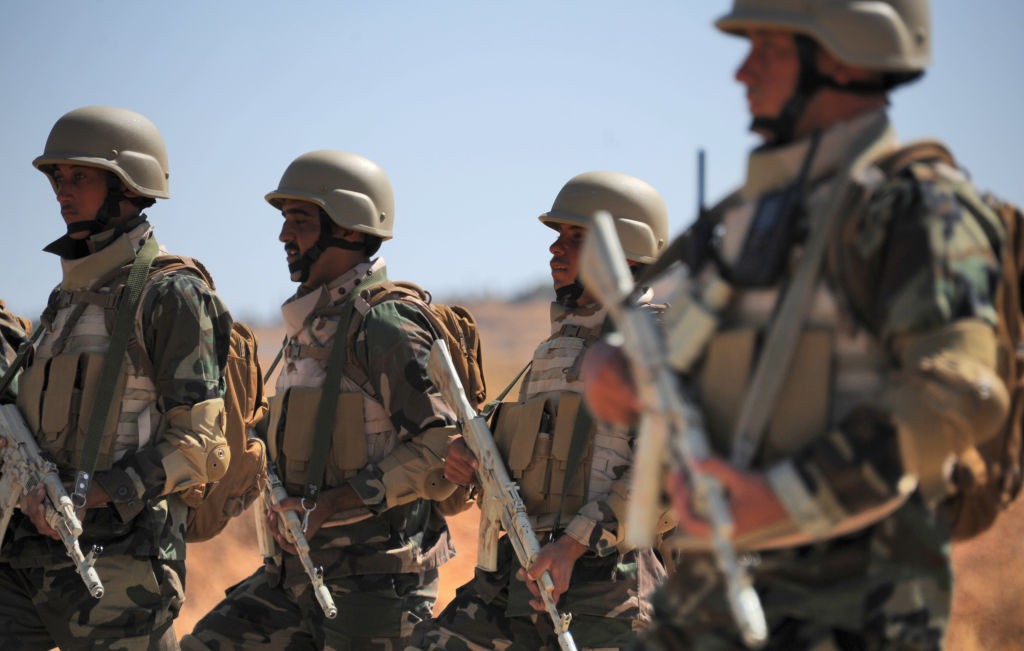
"The Alawite sect has been mobilized by the regime to participate in battles against the opposition across the country, and south-west Syria’s Alawites are no exception."
Alawites
The Alawites of south-west Syria form a small community (only 3,269 members in 2011), but one that is highly integrated with the local Sunni and Druze populations. Alawite-Sunni marriage is quite common, and most communities have maintained positive relations with their neighbors. The Alawite population has decreased by 22 percent, the lowest proportional decrease of all minority communities in the south-west. Nonetheless, the regime’s recruitment of Alawite militia fighters since 2011 has inflamed sectarian distrust and strife within and against several Alawite communities in the south-west, and their weaponization is the primary issue that has stressed the once-strong bonds between Daraa’s Alawites and Sunnis.
The Alawite sect has been mobilized by the regime to participate in battles against the opposition across the country, and south-west Syria’s Alawites are no exception. Beginning in 2012, the regime has been recruiting forces from the Alawite community in Kiheel, inflaming sectarian tensions in the city. Tit-for-tat killings of Sunnis and Alawites ensued, leaving nearly a dozen from each side dead. As the opposition’s territorial control grew, three quarters of Kiheel’s Alawite community fled to the Alawite village of Alqeen in northern Daraa.
Prior to the conflict, Alawites resided in four Daraa towns and one town in Suwayda. Although Alawite army officers, security personnel, and government employees lived in the region with their families as well, their residence was temporary. As such, this study only tallies the statistics for Alawite residents originally from the community. Due to the sectarian and nepotistic nature of the Assad regime, Alawites are often favored for high-level positions in the regime and military, in addition to public sector jobs. This is largely true in the south-west as well: most Alawites either make their income from government jobs or local business and are the least reliant on remittances from abroad.
Barriers to return
Following the partial return of regime authority to the south-west in July 2018, negotiations began for the return of displaced Alawites to Kiheel — the only major case of Alawite displacement in the region. Representatives from displaced Alawite families began talks with Ahmad al-Awdeh and the leadership of the 5th Corps. Al-Awdeh has so far rejected the return of any displaced Alawites to the south-west, citing concerns about the growing influence of the al-Bustan Charity, a Rami Makhlouf-owned organization that maintains close ties to armed militias and whose members in the south-west are largely recruited from Kiheel and Alqeen’s Alawite communities.
A second issue results from personal lawsuits by Alawites against Sunnis (especially former opposition fighters) in Kiheel. Al-Awdeh participated in long negotiations for a solution to these legal cases, but local officials encouraged Sunni defendants to counter-sue the Alawite plaintiffs after talks reached a stalemate. The standoff eventually resulted in an offer by Alawite representatives to sell all of their properties in Kiheel, but this proposal has been neither accepted nor rejected by al-Awdeh. Major General Hussam Luqa, the head of the regime’s Daraa security committee, met directly with local officials from Kiheel in December 2019 to propose the total return of the town’s Alawites, along with financial compensation to families of Alawite victims of violence in 2012 and 2013. No agreement has been reached, however, and negotiations remain deadlocked.
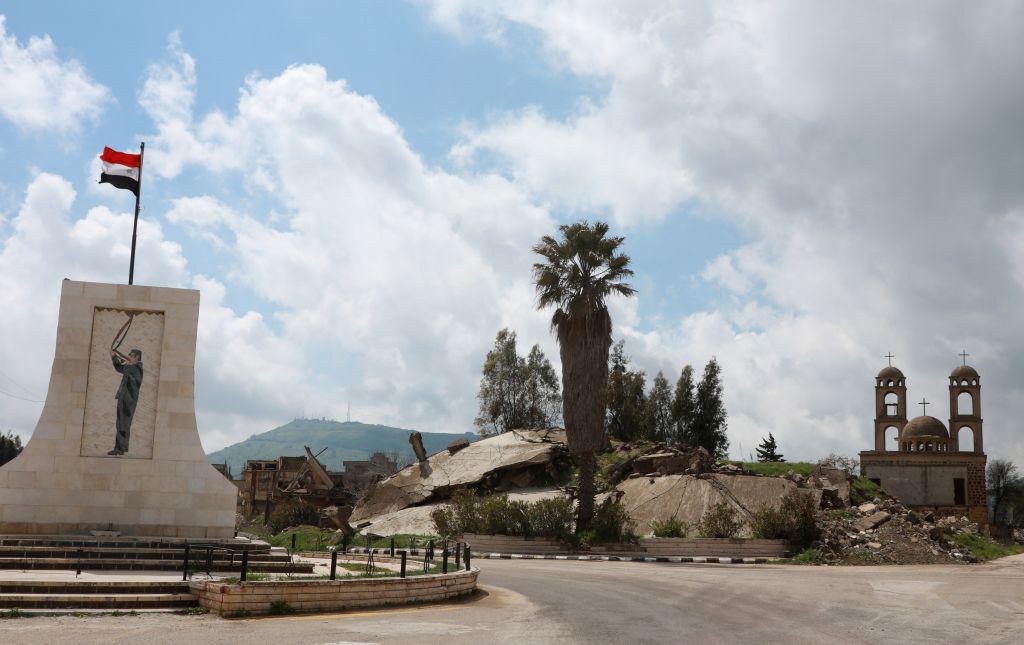
"Although 3,310 Circassians resided in south-west Syria prior to 2011, only 900 remain today, most having fled either to Damascus or abroad."
Circassians
The Circassians of south-west Syria are a predominately Sunni ethnic group who have largely retained their own cultural identity, distinguished from neighboring communities by their customs, traditions and language. Although 3,310 Circassians resided in south-west Syria prior to 2011, only 900 remain today, most having fled either to Damascus or abroad.
As the regime escalated military operations against the south in the latter half of 2012, and the conflict between opposition and regime forces grew more violent, Circassians began to leave Quneitra Province. The majority of the south-west’s Circassians previously resided in three towns, but by early 2013, all three had been completely cleared of all their residents, with opposition fighters and their families settling in abandoned Circassian homes. Some of these displaced residents would go on to leave Syria, either for Europe, Turkey or the disputed Abkhazia region of Georgia.
Following the 2018 settlement agreement, MI and the head of Quneitra’s Baath Party, Khaled Abaza, coordinated to remove all former opposition fighters and their families from the three villages, allowing the first convoy of Circassians to return to their homes in August 2019. Still, their population only numbers 27 percent of its former size across the south-west. An additional 200 Circassian families reside in Damascus, and their future return is possible.
Disproportionate representation
Circassians have remained largely neutral since the start of the conflict, yet members of the small community have risen to positions of power and influence within the regime. The Abaza family in particular has risen to a position of political prominence, starting with Brigadier General Walid Abaza’s appointment as Baath Party head in Quneitra, and the subsequent promotion of his son, Khaled Abaza, to the same position shortly afterwards. The Abaza family has used this position to recruit new members for the National Defense Forces (NDF) militia in Quneitra, but very few Circassians have volunteered to join the group.
Khaled Abaza’s stepmother, Janseit Qazan, is also a member of the Syrian parliament and currently listed on Syria’s congressional committee tasked with drafting a new constitution. The Abaza family has also cultivated deep relationships with tribal leaders and local figures in Quneitra, in addition to its regime and NDF connections, creating a disproportionately large degree of influence and representation for the Circassian sect when compared to other minority groups in the south-west.

"Despite the regime’s efforts to depict Assad as a defender of minorities, it is the regime’s destructive policies that perpetuate the violence and instability that has displaced minority communities and prevents their safe return home."
Conclusion
- Despite the regime’s efforts to depict Assad as a defender of minorities, it is the regime’s destructive policies that perpetuate the violence and instability that has displaced minority communities and prevents their safe return home. Ongoing efforts by the regime and Hezbollah to promote state-sponsored organized crime, assassinate former opposition and local officials, as well as recruit growing numbers of local youth into pro-regime militias will only perpetuate the cycle of violence and instability that prevents displaced Christians and other minorities from returning to their communities.
- The regime and Hezbollah are placing additional pressure on Suwayda’s Druze community and recruiting local armed groups to counterbalance Druze militias. In talks with local authorities in Suwayda, the regime has gone as far as threatening Suwayda’s Druze with a military invasion of their lands if they do not submit to regime rule. This looming uncertainty regarding Suwayda’s current relative autonomy, coupled with deteriorating economic and security conditions, has pushed many of Suwayda’s youth to relocate elsewhere.
- Russia and the regime have placed the plight of displaced Christians at the very center of their propaganda narratives, yet despite the surrender of opposition forces in south-west Syria in July 2018, attempts to resettle Christians and other minorities in their homes have failed. Russian proposals to negotiate the return of Alawites and Shi’as to former opposition territory have been rejected, owing to the recruitment of large portions of these communities into pro-regime militias. For Christian communities, Russian-backed negotiations for their return have not made headway in nearly a year.
- Even in the absence of logistical and political barriers, the prospect of returning to their former communities is unpalatable for many displaced minorities. Growing instability in the south-west, along with economic stagnation, prevents the return of Christians, Druze, and Circassians to their homes. Valid concerns among former opposition authorities about Hezbollah and regime intelligence infiltration of Alawite and Shi’a communities — which have been heavily targeted for recruitment by these groups — also present a significant hurdle.
About the Middle East Institute
The Middle East Institute is a center of knowledge dedicated to narrowing divides between the peoples of the Middle East and the United States. With over 70 years’ experience, MEI has established itself as a credible, non-partisan source of insight and policy analysis on all matters concerning the Middle East. MEI is distinguished by its holistic approach to the region and its deep understanding of the Middle East’s political, economic and cultural contexts. Through the collaborative work of its three centers — Policy & Research, Arts & Culture and Education — MEI provides current and future leaders with the resources necessary to build a future of mutual understanding.
About ETANA Syria
ETANA, a Syrian organization established in Damascus in 2001, is committed to achieving a democratic, inclusive future for all Syrians. Since the onset of the Syrian crisis, ETANA has worked to find a sustainable political solution by building linkages and accountability between local communities, as well as the international community. It focuses on providing accurate reporting and analysis of the situation on the ground in Syria, which has proven vital to achieving coherent Syria policy. Follow ETANA’s work on Twitter @ETANA_Syria.












